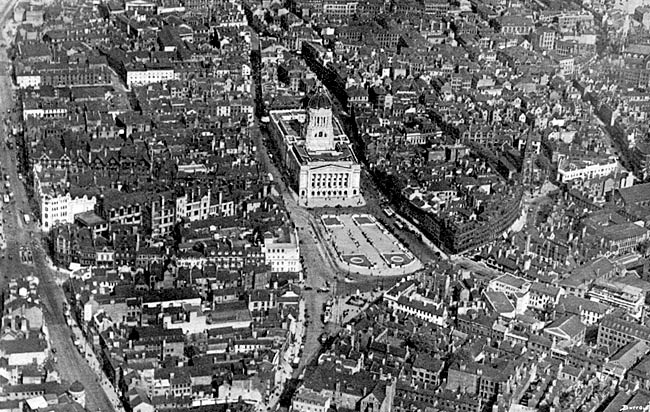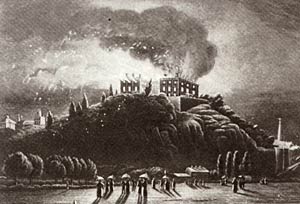< Previous | Contents | Next >
The Stately Queen of the Midlands

Aerial view of Nottingham city centre in the early 1930s.
NOTTINGHAM. She is the Queen of the Midlands, and is making herself more beautiful than ever. She is a great industrial city and will soon have 300,000 people living on her industries; yet it may be said of her that she is renewing her youth like the eagle, and even in these years of transition and transformation Nottingham is a beautiful place.
It will soon be eight centuries since Nottingham received its charter, but not half a century has passed since it was made a city, and in these 50 years those who have been looking on at Nottingham have witnessed a great tragedy and a great triumph. They have seen the long, slow breaking-up of an industry that made this city famous through the world. Nottingham lace was everywhere, in cottages and palaces and in every land. Its lace factories hummed with prosperity; the lace market was the throbbing hive of the town. The lace machines were wonderful to behold.
It was fashion that struck a bitter blow at the heart of this great scene. Nottingham lace has had its day.
But, though beauty passes, cities do not perish, and Nottingham has faced adversity with a spirit that has known no bounds. It has made its power felt in English education and established a University College which is not to be beaten as a spectacle in any English city, and for efficiency and progress is second to none in the provinces. It has laid out nine miles of boulevards, and preserved the old Forest. It has bought a great Tudor hall which in itself would give distinction to any town. It has added Lord Byron's home to the possessions of the city. It has built a new bridge over the Trent, and has beside it one of the finest memorials any city has set up to its heroes. It has used its noble castle in the noblest way. It has swept away the biggest open marketplace in England and made it into a public square, with a city hall of great magnificence rising at the end of it. It has become the centre of a new railway linking London with Manchester, and has taken to itself village after village from the country round. In one of the streets began two mighty enterprises: a business which has grown until it has about a thousand shops, and a work which is now world-wide, world-needed, and world-honoured, the Salvation Army. The founder of the shops was Jesse Boot, the founder of the Army was William Booth, and both began in Hockley, two streets away from Nottingham's City Centre.
More than all this, Nottingham has turned itself in half a generation into England's most inland river port, building dams with locks and weirs as far as Newark, so that the Trent has a permanent channel to the sea. It has made itself an important airport with an aerodrome of 140 acres at Tollerton, three miles away.
It is not a bad record for a city faced with bitter adversity, and all this time this stronghold of our industrial Midlands has been sweeping its slums away, making itself worthy of its great future in the spirit of its historic past.
Nottingham has a prehistoric past of which little is known, for it has a remarkable group of rock-hewn chambers, of holes and caves and underground passages hollowed out in the soft sandstone rock; and in these it is believed that tribes of Ancient Britons lived before the Romans came, finding their food in the river and in the forest where bears and wolves abounded and timber could be had for fueling and building. It is known that for centuries the caves of Nottingham were used as dwellings. We see some of them still cut out of the castle rock, one a chamber with three windows and doorway; and there are hollowed-out dwellings in the picturesque Rock Cemetery looking down on the Forest. Every schoolboy in Nottingham knows that Robin Hood and his Merry Men lived in them, and every historian knows that they were the home of ancient tribes who formed the nucleus of the great community that has now grown up in Nottingham till it is 280,000 strong, in homes spread over 16,000 acres.
The Romans were hereabouts, but the town has no trace of them; the Saxons made it a place of importance (Snotingaham), and the Normans gave it the name we know. The Saxons are said to have built a tower on the summit of the great rock which rose above the marshes on the edge of the dense forest, and not long after Egbert had consolidated England the Danes came down the Trent and planted their standard on the Rock. King Alfred, after a long struggle, compelled them to come to terms, and in the division of the country which followed Nottingham became the chief of the five Danish Burghs. Alfred's son began the reconquest of Danish England, and recovered the old kingdom, his success in the Midlands culminating in the capture of Nottingham. He fortified it with a wall and a ditch, giving the wall towers and gateways, and cutting most of the ditch from the solid rock. He threw a bridge across the Trent and built Bridgford. Athelstan, first king crowned for all England, set up a mint here, and his coins have the mark of the town.
In the days of the Normans the story of the town became closely linked with that of the castle, which the Conqueror ordered William Peverel to build on the precipitous Rock. The Normans settled about the castle and left the people undisturbed, so that for a time there were two races in Norman Nottingham, the Saxons in the English borough on St Mary's Hill, the Normans in the French borough, each borough having its own laws and customs, its town hall, and its mint. Henry the First rebuilt William Peverel's wooden fortress in stone, but his castle was burned down, and was rebuilt by Henry the Second, whose energy and goodwill Nottingham has reason to remember. He gave it its first charter in 1155, and in 1177 held in the town a council for establishing judicial circuits throughout the land. He helped the people to rebuild the town and closed it with more extensive fortifications, and encouraged the dyed-cloth industry which was growing. He held Nottingham Castle as a royal fortress and rebuilt it on a grander scale, and he loved to hunt in the neighbouring Sherwood Forest. He gave the castle to his terrible son John, to whom, in spite of his cruelty, Nottingham was always loyal. Yet the town has witnessed no more ghastly scene than that enacted on the castle ramparts in 1212, when John, furious at the news of another Welsh rebellion, ordered the hanging of 28 youths who were held as hostages for the good conduct of their fathers.
The son of the Norman founder of our Parliament, Simon de Montfort, became Governor of the castle in due course, and in the reign of Edward the First the town elected its own mayor. Edward the Second lived at the castle, and in the early years of Edward the Third his mother, Queen Isabella, and her favourite Roger Mortimer, established themselves here. In 1330 they were captured by the young king and his followers, who secretly entered the castle by the passage through the rock known as Mortimer's Hole. We may go down it today. Edward held several Parliaments here where laws were passed which were to have a great influence on the growing trade of the town, the manufacture of wool into cloth. Richard the Second sat here in conference with his judges, and sought in vain to encroach on the liberties of the people. Henry the Fourth found refuge here during rebellions and here he imprisoned Owen Glen-dower. Edward the Fourth proclaimed himself king from the castle and here denounced Warwick the Kingmaker as a traitor. He lived here in sumptuous style and made many improvements in the castle which were completed by his bloodstained successor Richard the Third. We may still see part of a tower built by Richard; it is in a garden near by.

Colonel John Hutchinson (1615-1644).
It was from Nottingham that Richard set out for Bosworth Field, there to end the Plantagenet dynasty and to bring in the reign of the Tudors; and it was at Nottingham, when the Tudor dynasty was over, that Charles Stuart raised his standard on Standard Hill, at a spot marked by a tablet in the roadway looking down to the castle grounds; it is near the entrance to the hospital. It was during the Civil War that the heroic Colonel Hutchinson held the castle for the Parliament, refusing the Duke of Newcastle's offer of £10,000 and the gift of the castle if he would join the king's side. His answer was that if the duke wanted the castle he must wade to it through blood, and the story of the colonel's courage in holding the town is nobly told by Lucy Hutchinson in her memoirs of her husband's life. When the war was over Parliament gave the garrison a thousand pounds, and the castle itself was dismantled and mostly demolished. The first Duke of Newcastle cleared away the ruins, and he and his son transformed the walls into a ducal palace. Part of the duke's statue on horseback, cut from a single block of stone, is still in its original place over the north doorway.

Nottingham Castle in flames, 1831.
In the days of the Industrial Revolution, when the poor stockingers were driven by hunger to smash the machines they blamed for their plight, Nottingham was the scene of much rioting, which was renewed when the Reform Bill was rejected by the House of Lords. The castle was burned by the mob and remained a blackened and roofless shell for over 40 years. Its long place in the political history of England was over, and its new life as an art museum was begun.
